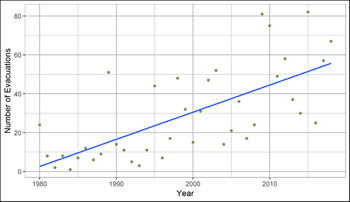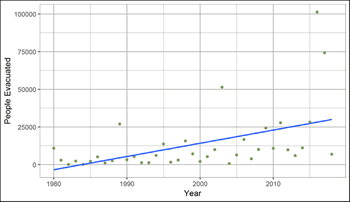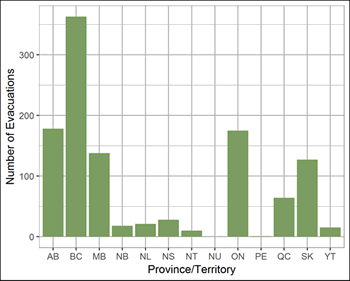Wildland fire evacuations are a tool used to prevent injury and death when wildland fires threaten communities. Evacuations occur when wildland fires get close to communities, threaten infrastructure or when smoke endangers human health.
A wildland fire evacuation is defined as any situation in which people occupying a particular location leave that location as the result of wildland fire proximity, smoke or power outage.
In Canada, the number of evacuations caused by wildland fires and the number of evacuees increased between 1980 and 2018. These numbers are expected to continue to rise as climate change leads to increases in the number, size and intensity of wildland fires.
Changes in the number of evacuations caused by wildland fires is an important indicator of how climate change is impacting Canadians and where adaptation measures are most needed.
- Why wildland fire evacuations are important
- What has changed
- The outlook
- Adaptation tools and resources
Read how wildland fire evacuations and its indicators are defined
Why wildland fire evacuations are important
When infrastructure, including homes, roads, power lines or businesses, meets or is dispersed within wildland areas containing flammable vegetation, fire threatens human life and property.
The socio-economic impacts of wildland fire are quite significant. Between 1980 and 2018, an average of 7,400 wildland fires occurred each year in Canada; causing 29 communities and 13,000 people to evacuate. Alberta’s 2016 Fort McMurray fire was the most expensive natural disaster in Canadian history with $3.77 billion in insurance costs and 2,400 buildings lost.
Tracking wildland fire evacuations helps determine whether communities that are close to forested areas are being increasingly affected by wildland fire activity. This information also helps communities adapt to climate change in the context of wildland fire.
What has changed
Since 1990, wildland fires have burned an average of 2.5 million hectares of forest each year in Canada. However, wildland fire activity varies widely from one year to the next.
Available records indicate that the annual number of wildland fire evacuations (Figure 1) and the number of wildland fire evacuees (Figure 2) increased between 1980 and 2018. During this period, British Columbia had the highest number of evacuations and evacuees in Canada (Figure 3). Many people live in or near forested areas in British Columbia. As a result, the effect of wildland fire on these communities is typically greater than in other parts of Canada.
The low frequency of wildland fires combined with low population densities in other areas of Canada has resulted in relatively few evacuation events over time. However, when large fires do occur in highly populated areas, such as Fort McMurray in 2016, the results can be extremely damaging.
The number of residential losses can be very different depending on the size of the communities being evacuated and the ability of emergency responders to protect property. From 1980 to 2018, there were 0.713 homes lost for every 100 people evacuated in Canada.

Figure 1 – Annual number of wildland fire evacuations in Canada for the period 1980–2018
Larger image [17 Kb]

Figure 2 – Annual number of evacuees (in thousands) as a result of wildland fires in Canada for the period 1980–2018
Larger image [16 Kb]

Figure 3 – Annual number of wildland fire evacuations by Canadian province and territory for the period 1980–2018
Larger image [19 Kb]
Graph data - Figure 1
| Year | Number of evacuations |
|---|---|
| 1980 | 26 |
| 1981 | 8 |
| 1982 | 2 |
| 1983 | 8 |
| 1984 | 1 |
| 1985 | 9 |
| 1986 | 12 |
| 1987 | 6 |
| 1988 | 8 |
| 1989 | 50 |
| 1990 | 12 |
| 1991 | 12 |
| 1992 | 4 |
| 1993 | 3 |
| 1994 | 13 |
| 1995 | 44 |
| 1996 | 7 |
| 1997 | 17 |
| 1998 | 49 |
| 1999 | 33 |
| 2000 | 15 |
| 2001 | 32 |
| 2002 | 49 |
| 2003 | 53 |
| 2004 | 16 |
| 2005 | 22 |
| 2006 | 37 |
| 2007 | 17 |
| 2008 | 28 |
| 2009 | 82 |
| 2010 | 69 |
| 2011 | 43 |
| 2012 | 54 |
| 2013 | 34 |
| 2014 | 25 |
| 2015 | 82 |
| 2016 | 25 |
| 2017 | 57 |
| 2018 | 67 |
Graph data - Figure 2
| Year | Number of evacuees (x 1,000) |
|---|---|
| 1980 | 10.92 |
| 1981 | 2.95 |
| 1982 | 0.11 |
| 1983 | 2.37 |
| 1984 | 0.04 |
| 1985 | 2.21 |
| 1986 | 5.16 |
| 1987 | 1.15 |
| 1988 | 2.52 |
| 1989 | 27.00 |
| 1990 | 3.31 |
| 1991 | 5.32 |
| 1992 | 1.23 |
| 1993 | 1.30 |
| 1994 | 6.06 |
| 1995 | 13.70 |
| 1996 | 1.67 |
| 1997 | 3.01 |
| 1998 | 15.75 |
| 1999 | 7.18 |
| 2000 | 2.06 |
| 2001 | 5.30 |
| 2002 | 9.96 |
| 2003 | 51.35 |
| 2004 | 0.65 |
| 2005 | 6.39 |
| 2006 | 16.65 |
| 2007 | 3.87 |
| 2008 | 10.03 |
| 2009 | 23.71 |
| 2010 | 7.73 |
| 2011 | 26.36 |
| 2012 | 9.26 |
| 2013 | 5.48 |
| 2014 | 10.92 |
| 2015 | 28.26 |
| 2016 | 101.28 |
| 2017 | 74.29 |
| 2018 | 6.92 |
Graph data - Figure 3
| Province/ territory | Number of evacuations |
|---|---|
| AB | 178 |
| BC | 363 |
| MB | 138 |
| NB | 18 |
| NL | 21 |
| NS | 28 |
| NT | 10 |
| ON | 175 |
| PE | 1 |
| QC | 64 |
| SK | 127 |
| YT | 15 |
The outlook
The number of wildland fire evacuations and evacuees as well as the costs of evacuating are expected to continue increasing in the 2020s.
Climate change is expected to cause increased drought, longer fire seasons and more extreme weather causing lightning strikes. Each of these factors are expected to contribute to greater numbers of fires, higher-intensity fires, and more area burned by wildland fires.
How indicators of wildland fire evacuations are defined
Wildland fire evacuations in Canada involve multiple government agencies and supporting organizations like the Canadian Red Cross, which participate in efforts to meet the basic needs of those affected. Compiling of national data on wildland fire evacuations is complex as agencies have records for a limited jurisdictional boundary or context, and the format of the information is often different.
The wildland fire evacuation indicators include:
- number of evacuations
- number of evacuees
- location of evacuation
These indicators were estimated for the period 1980–2018 using key word searches of news articles and databases documenting wildland fire evacuations in Canada. These bibliometric data have limitations resulting from variability in the level of reporting across agencies and to the difficulty of compiling this information (see: Wildland fire evacuations in Canada 1980-2007). For instance, data accuracy is lower for Nunavut. Similarly, data from the 1980s are more difficult to compile than recent data, which are more readily available through electronic access to media publications.
Sources and references for wildland fire evacuations and its indicators
- Beverly, J., and Bothwell, P. 2011. Wildfire evacuations in Canada 1980–2007. Natural Hazards 59, 571–596.
- Harris, L.M., McGee, T.K., and McFarlane, B.L. 2011. Implementation of wildfire risk management by local governments in Alberta, Canada. Journal of Environmental Planning and Management 54, 457–475.
- Hofstetter, C.R., and Dozier, D.M. 1986. Useful news, sensational news: Quality, sensationalism and local TV news. Journalism Quarterly 63, 815–820, 853.
- Price, D.T., Alfaro, R., et al. 2013. Anticipating the consequences of climate change for Canada’s boreal forest ecosystems. Environmental Reviews 21, 322–365.
- Stocks, B.J., and Flannigan, M.D. 2013. Current fire regimes, impacts and likely changes: Past, current and future boreal fire activity in Canada. In Goldammer, J.G. (ed.), Vegetation fires and global change: Challenges for concerted international action, 39–50. Remagen, Germany: Kessel.
- Taylor, S.W., Stennes, B., et al. 2006. Integrating Canadian wildland fire management policy and institutions: Sustaining natural resources, communities and ecosystems. In Hirsch, K.G., and Fuglem, P. (technical coordinators), Canadian Wildland Fire Strategy: Background syntheses, analyses, and perspectives, 3–26 Edmonton, AB: Canadian Council of Forest Ministers.
Adaptation tools and resources
Fire Smart Canada – helps people understand the potential of wildland fire affecting homes and communities; includes a risk reduction program for forestry companies
Forest Change Toolkit – a list of tools and resources for climate change adaptation
Canadian Wildland Fire Information System (CWFIS): creates daily fire weather and fire behavior maps year-round and hot spot maps throughout the forest fire season, generally between May and September.
- Aponte, C., de Groot, W.J., et al. 2016. Forest fires and climate change: causes, consequences and management options. International Journal of Wildland Fire, 25 (8), i-ii.
- Beverly, J.L., Flannigan, M.D., et al. 2011. The association between Northern Hemisphere climate patterns and interannual variability in Canadian wildfire activity. Canadian Journal of Forest Research 41, 2193-2201.
- Campos-Ruiz, R., Parisien, M.A.,et al. 2018. Temporal patterns of wildfire activity in areas of contrasting human influence in the Canadian boreal forest. Forests, 9 (4), 159
- Cardil, A., Lorente, M., et al. 2018. Factors influencing fire suppression success in the province of Quebec (Canada). Canadian Journal of Forest Research 49, 531–542.
- Faulkner, H., McFarlane, B.L., et al. 2009. Comparison of homeowner response to wildfire risk among towns with and without wildfire management. Environmental Hazards 8: 38-51.
- McFarlane, B.L., McGee, T.K., et al. 2011. Complexity of homeowner wildfire risk mitigation: An integration of hazard theories. International Journal of Wildland Fire 20(8):921-931.
- McGee, T.K., McFarlane, B.L., et al. 2009. An examination of the influence of hazard experience on wildfire risk perceptions and adoption of mitigation measures. Society and Natural Resources 22, 308–323.